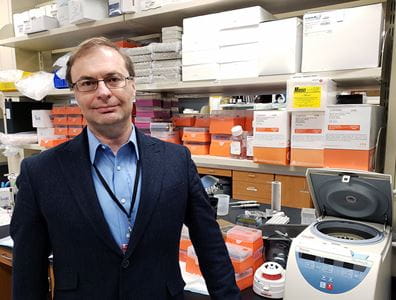Nearly a decade ago, Mircea Ivan, MD, PhD, and colleagues started down a path to identify new genes that help cells adapt when oxygen is deprived, but in the process, they followed the science, which took them in a different direction. Their work has just been published in the prestigious Nature Communications. Equally exciting, the National Center for Biotechnology Information (NCBI) updated its website by renaming the gene Ivan studied “lincNORS,” which is the name he coined for it. “This is quite big,” Ivan said. He answered questions about his recent work.
In your words, what is the single main purpose of this study?
A: The initial purpose of the study, which began almost a decade ago, was to identify new genes that help cells adapt to circumstances when oxygen becomes insufficient. In 2011, Xue Wu, then in the early stages of her doctoral project in my lab at IU, identified a novel RNA (later termed lincNORS) that was becoming more abundant in cells subjected to oxygen deprivation. After years of experiments and bioinformatic analyses, our team reached a completely unanticipated destination, beyond the strict confines of oxygen monitoring. In short, our paper provides the first piece of evidence that lincNORS functions as a feedback regulator of growth and development. Based on our data, this RNA molecule is particularly active in hormone-responsive cells, while at organismal level, it represents a significant determinant of sexual maturation in both males and females.
What is the significance of the findings?
A: We believe that this study is significant on multiple levels and for a variety of fields. The rapidly growing interest in the vast class of noncoding genes has resulted in an exponential increase in publications, as anyone performing a PubMed search can immediately verify. However, only in rare cases do such studies provide evidence from genome-wide association studies (GWAS) that is consistent with the biochemical studies. In our case, while the molecular biology studies were being performed, we became aware that multiple such studies listed natural genetic variations in the vicinity of our lincNORS. What was particularly exciting for us was that the phenotypes reported in these high-profile publications were consistent with our experiments. In other words, “Mother Nature” was sending us repeated signals that we were on the right track.
What are the strengths of your study?
A: Arguably the main strength of our study is its integrative nature and the consistency between population genetics data and the experimental effects of lincNORS. It is generally accepted that genetic variations associated with human phenotypes often occur in, or close to, noncoding genes. However, in-depth studies that provide a more formal relationship between these types of genes and respective phenotypes remain exceedingly rare.
Were you surprised by the results?
A: In the beginning, we did not think much beyond hypoxia, so from the vantage point of 2014 the portrait of lincNORS is indeed very surprising. I think this is the unique satisfaction of a scientist’s life, those “aha” moments that lead to an unexplored territory when you follow the “breadcrumbs” left by nature.
What are the implications of your findings?
A: The most immediate implications of lincNORS characterization are for human physiology, providing a better understanding of growth development and development processes. The presence of lincNORS should be considered each time a GWAS tags this genomic region as significantly associated with a phenotype.
Initially, will your study be of most interest to other researchers?
A: I believe so. A few examples that come to mind are researchers working in reproductive sciences, groups interested in hormonal responses, or the biology of cellular sterols and steroids. The relevance of lincNORS may in fact be even wider, as suggested by recent genetic associations with specific aspects of heart and thyroid function. As these studies still await independent replication, they were not discussed in the manuscript but may be of interest in the future.
In addition to scientists, our findings may also resonate with the general public. After all, the transition from childhood to adolescence is such an important and intriguing process for every member of our species.
Finally, you happened to notice that the NCBI updated its website by calling the gene you studied with the name you coined for it, lincNORS. What was that moment like for you?
A. My collaborators and I were very excited about it, naming a gene and be recognized by the NCBI represents a recognition of our work and a legacy for future generations.
